Abstract:
Gonadotropin-Releasing Hormone (GnRH) is a key endocrine secretion in the human/mammalian reproductive system. Therefore, understanding GnRH and its impacts on the human reproductive system of both sexes can give us clues to develop some safe and viable birth control solutions. If we are looking at upcoming prospects of GnRH in the arena of birth control, it can save the human race from various anomalies in the future.
Introduction:
According to Wikipedia, “About 222 million women who want to avoid pregnancy in developing countries are not using a modern birth control method. However, the present birth control methods used in the developing countries have decreased the number of deaths during or around the time of pregnancy by 40% in 2008, and could prevent 70% if the full demand for birth control solutions is met.”
“Globally, as of 2009, approximately 60% of those who are married and able to have children use birth control. How frequently different methods have been used are varying widely among countries.”
The same article also presented interesting statistics:
- The most common methods in the developed world are the use of condoms and oral contraceptives.
- In Africa, it is oral contraceptives.
- In Latin America and Asia, it is sterilization.
In the developing world overall,
- 35% of birth control is via female sterilization
- 30% is via IUDs
- 12% is via oral contraceptives
- 11% is via condoms
- 4% is via male sterilization
It establishes the significance of oral contraceptives as well as issues the warning against the high percentage of female sterilization techniques, which is never advisable in teenagers and youngsters opt for kids.
Despite the present proliferation of various birth control methods, human society is still looking for more advanced and personalized methods to prevent pregnancy.
It means birth control is directly associated with pregnancy. So, understanding pregnancy at a biological point of view is crucial to get insights into the birth control methods with hormones like GnRH (Gonadotropin-releasing Hormone) and its derivatives.
Normal Menstruation Cycle without Pregnancy:
A woman’s reproductive system has four underlying components:
- Ovaries with the ovarian cycle
- Uterus with uterine cycle
- The rhythm of ovarian hormones
- The rhythm of pituitary hormones
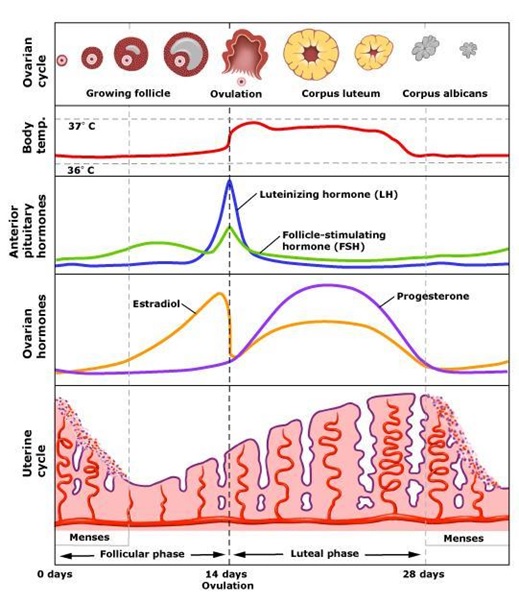
Med Bullets have beautifully illustrated the menstrual cycle and associated hormones in a nutshell.
- Ovary passes through the different phases in a normal menstrual cycle without ending in pregnancy: Growing follicles – Ovulation – CL (Corpus Luteum) – CA (Corpus Albicans)
- Uterus passes through Menses – Follicular phase – Luteal phase – Menses. It means the uterus experiences the growth in the uterine lining steadily from the onset of the follicular phase to the end of the CL phase. It exhibits sudden disintegration of the uterine lining during the CA phase, where the absence of supporting hormones takes place.
- Ovarian Hormones like Estradiol are found high during the Follicular phase, or before ovulation occurs, and Progesterone is found high during the Luteal phase after the ovulation occurs.
- Anterior Pituitary hormones like LH (Luteinizing Hormone) & FSH (Follicular Stimulating Hormone) exhibit a sudden surge at the time of ovulation.
Menstruation Cycle with Pregnancy:
If the conception takes place during a menstrual cycle, it ends up in a pregnancy.
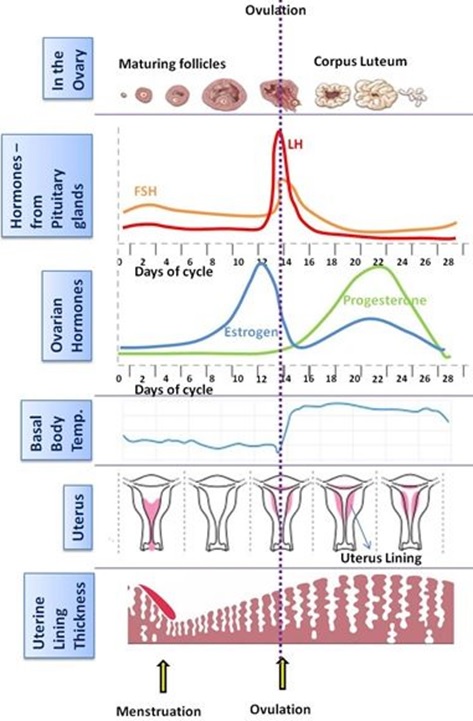
You can notice some obvious changes in the given illustration on Pinterest.
- You can see the absence of the Corpus Albicans phase at all. It means CL is not disintegrating and remains intact to produce pregnancy supporting hormones further.
- Thus, no disintegration of the uterine lining is taking place at all.
- Ovarian and pituitary hormones show pregnancy supporting hormonal patterns.
The Role of Hormones in Ovulation:
We have seen that various levels of different hormones play vital roles in the occurrence of pregnancy in the woman. Out of those, the group of hormones causing ovulation is important for birth control. So, yes, it is ovulation that is responsible for the conception, fertility, and pregnancy in a woman.
In the presentation of MedlinePlus, it becomes more comprehensive.

LH & FSH from the pituitary gland in Hypothalamus stimulate the women’s ovaries and produce & rip the eggs. Moreover, it causes the ovulation or extraction of eggs from the ovaries.

During a normal menstrual cycle, both hormones can grow the eggs in the ovary. Moreover, they can increase the thickness of the endometrium. Due to hormones, the cervical mucus thins that, easing the penetration of sperms during the coitus due to hormones.

LH from the pituitary gland is responsible for the ovulation process by acting on various ovarian and uterine hormones, including prostaglandins. Remember that without ovulation, ova cannot reach the fallopian tube of the uterus, and hence conception never occurs.
How Birth Control Pills Work at Hormonal Levels:
With a deep understanding of the mechanism of various hormones in the female reproductive system, we can get clues about how the birth control pills act and prevent ovulation or delay it for the desired period.

Combined Contraceptive Pills have estrogen and progestin or progesterone derivatives. Out of those, estrogen gives negative feedback to the pituitary gland to stop the secretion of LH. Thus, ovulation does not occur.

Similarly, progestin thickens the cervical mucus to stop the entry of nearly all healthy sperms.
Combined Birth Control Pills Are Not Safe at All
According to Med Bullets, combined contraceptive pills exert the following unwanted symptoms and become the cause of several fatal risks, such as:
- Depression
- Weight gain
- Nausea
- Hypertension
- No protection against STDs
- Increase in Triglycerides
- Hypercoagulability
- It has been seen in any increased estrogen state (OCP use, pregnancy)
- It can predispose to DVT’s an increased risk for PE
- Progestin, when it thickens the cervical mucus, also prohibits the entry of useful bacteria and ends up with decreased incidents of ectopic pregnancy thanks to less PID.
- High risks of endometrial & ovarian cancer were found to be associated with the use of contraceptive pills.
What Is the Safe Remedy?
Now, the question is how to overcome such risks associated with the increased usage of various contraceptive pills based on hormones and their derivatives? Now, experts fully understand the entire reproductive endocrine mechanism working in pregnancy.
They have isolated GnRH as a potential hormone to target for prospective birth control or contraceptive methods. So let’s dive deep into the world of GnRH.
What Is GnRH?
It is a tropical peptide hormone synthesis and released from the GnRH neurons. According to Wikipedia, it is responsible for the release of mainly FSH and LH-like reproductive hormones.
Location:
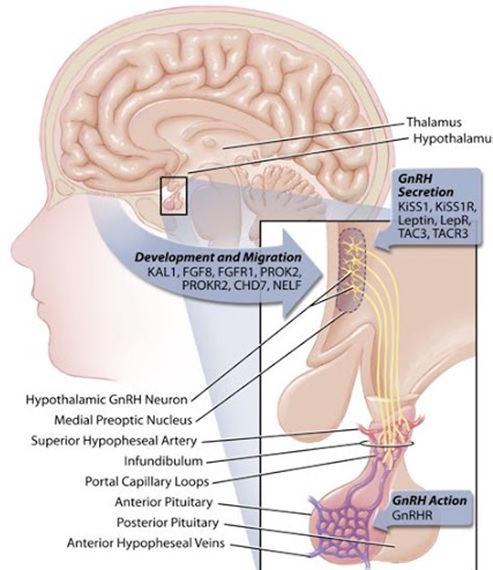
According to Science Direct, GnRH neurons are mainly located in HTA in the regions of the Arcuate Nucleus, which is at the base of the Hypothalamus near the Median Eminence. GnRH neurons are also scattered across the other areas in the Hypothalamus or around the pituitary gland.
Pulsatile Secretion:
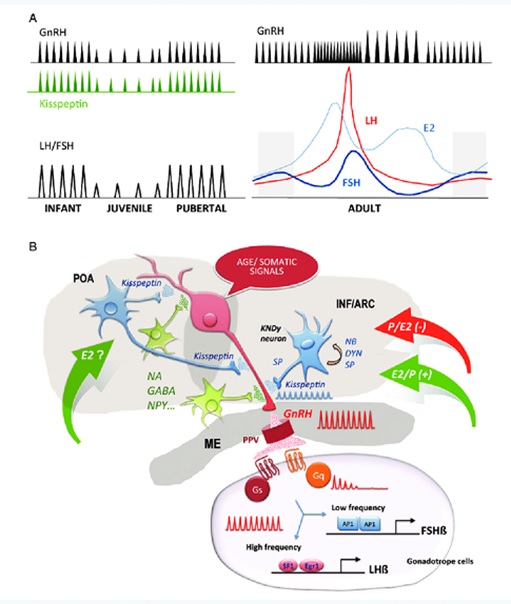
Pulsatile secretion of GnRH is an intrinsic property of GnRH neurons. The same pulsatile frequency and amplitude influence the regular neurons like Kisspeptin, which are synapsis with GnRH neurons. Kisspeptin neurons release a family of peptides, Kisspeptins, which are responsible for the modification and stimulation of GnRH secretion via various feedback methods.
Structure of GnRH:
Nobel Laureates et al. (1977)1 described it as pyroGlu-His-Trp-Ser-Tyr-Gly-Leu-Arg-Pro-Gly-NH2.
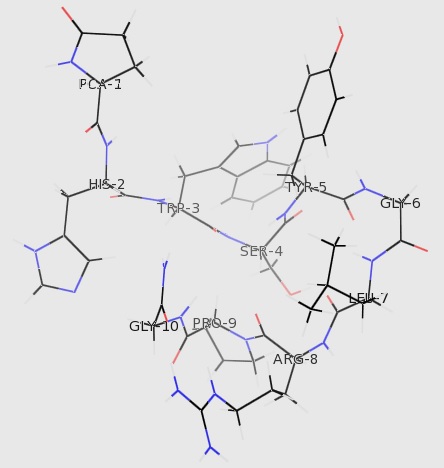
They assume that all amino acids are in L-form, and they use standard abbreviations for the proteinogenic amino acids.
The Function of GnRH in the Human Reproductive System:
In the sections above (location & pulsatile secretion of GnRH), we have seen images that beautifully describe GnRH’s function from release to disintegration. In a nutshell,
- GnRH secretes in the bloodstream of the hypophysial portal located in the median eminence.
- The blood portal passes the GnRH to the gonadotroph cells in the pituitary gland.
- Here, GnRH activates its receptor, GnRH-R (gonadotropin-releasing hormone receptor)
- The receptor is a seven-transmembrane G-protein-coupled receptor, which stimulates the beta isoform of Phosphoinositide phospholipase C
- It can mobilize calcium and protein kinase C.
- It results in the activation of proteins involved in synthesizing and secretion of the gonadotropins LH and FSH.
- GnRH is degraded by proteolysis within a few minutes.
The Activity of GnRH:
- GnRH activity was found to be very low during childhood.
- It is found high in puberty or adolescence.
- However, pulse activity remains vital during the reproductive years and plays a key role in successful reproductive function.
- Feedback loops control the secretion.
- However, once a pregnancy is established, GnRH activity is not required.
The Role of GnRH in Male Reproduction:
The responsibility of birth control should not be on a female partner only. The male partner must have a share of it. However, the adoption of vasectomy in males is a debated issue across developed and developing nations. However, the adoption rate is meager to say.
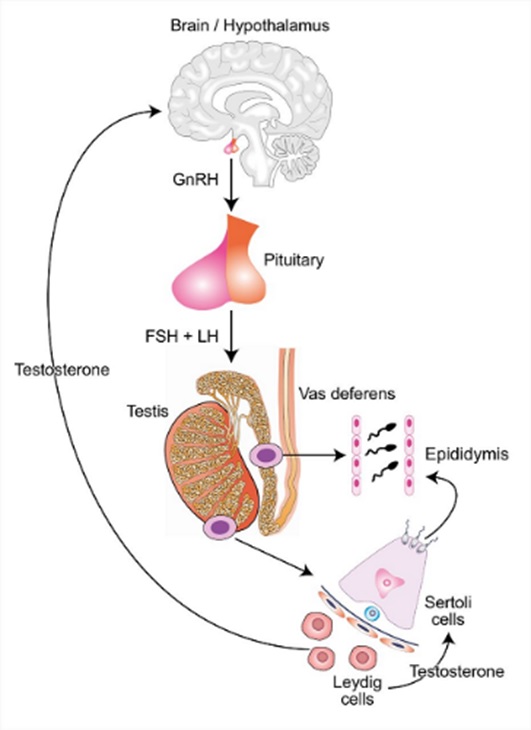
The lifecycle of Sperms:
- If we look at the spermatogenesis (sperm production) process, the role of the Hypothalamus is vital.
- GnRH triggers the release of LH & FSH in the male anterior pituitary gland.
- Blood levels of both hormones act on Leydig & Sertoli cells in the male testis.
- Testosterone generates in Leydig cells and disperses in the bloodstream to initiate various male reproductive functions.
- A high testosterone level in testicular areas supports Sertoli cells to play their roles in spermatogenesis.
- Growing sperms migrate through seminiferous tubules and are stored as mature sperms in Epididymis.
- During the ejaculation process, sperms migrate to the urethra vial Vas Deferens and reach the woman’s uterus during coitus to make her pregnant.
Negative Feedback Loop in Male Reproduction:
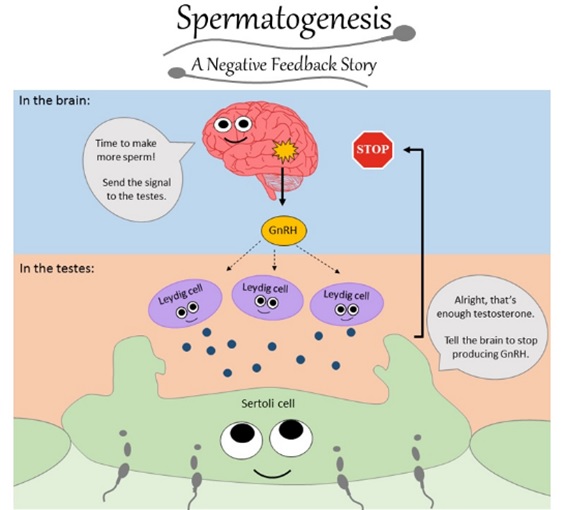
John & Richard (2019)2 have cited clearly in BMJSRH that despite the administration of hormonal and nonhormonal drugs or auto-implants, results are not satisfactory, and a series of novel methods are still under the clinical trials.
Now, they are looking for potential in GnRH agonists and antagonists’ applications. Of course, the response of antagonists is effective.
In the Signal Noise Magazine, Lynnea Waters (2017) cited that the prevention of the secretion of GnRH through the feedback loop is the best and basics of male hormonal birth control or male contraception method. The combination of therapies like a testosterone feedback loop and progestin can successfully inhibit GnRH secretion.
GnRH in Male Contraception:
The advances in basic science to understand the endocrinology of the male reproductive system have enabled us to target the GnRH effectively.
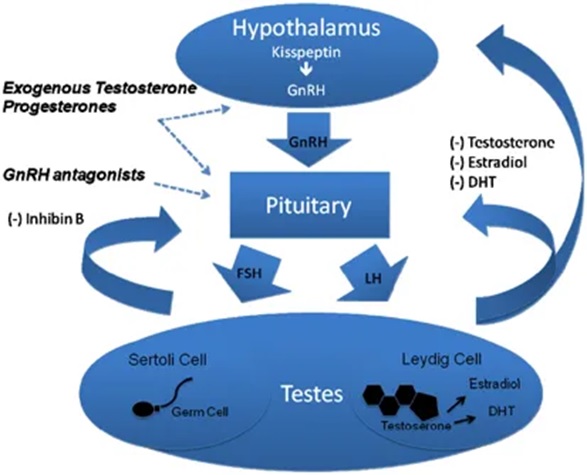
Manetti & Honig (2010)3 in Nature have provided deep insights into the endocrinology of the feedback mechanisms. In addition, it helped a lot to develop many non-surgical and hormonal alternatives for male contraception.
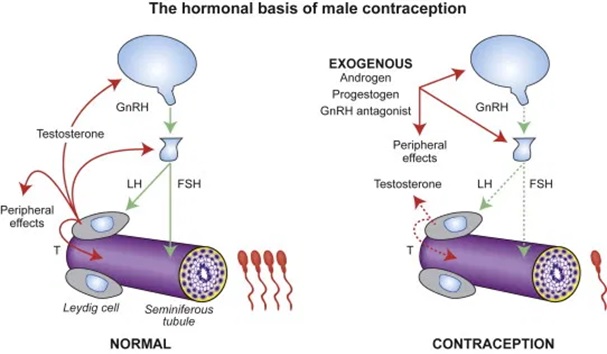
Drzezo (2017) has posted in OBSTETRICS the same conclusions regarding applying GnRH antagonists and Androgens in Male Hormone Contraceptive (MHC) regimens.
They found MHC adequately effective on the male reproductive axis to prevent pregnancy through reversible male infertility. Moreover, they have discussed the periodic vaccination of GnRH antibodies as a promising area of research in male contraception.
The Role of GnRH in Female Reproduction:
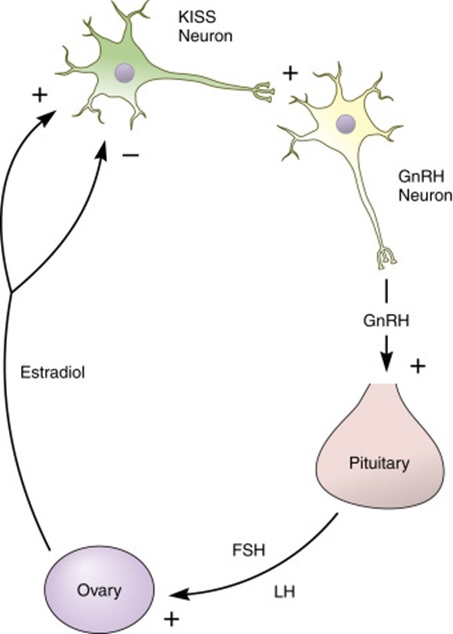
Richard E. et al. (2014) in Science Direct have described the endocrinology and physiology of the female reproductive system and the role of GnRH in the development of female contraceptives.
They found a peptide, Kisspeptin, from Kiss neurons responsible for a positive and negative feedback loop in GnRH generation and secretion. In addition, kiss neurons have physical intimacy with GnRH neurons.
They pinpointed Estradiol from the ovaries to create a feedback loop in the pituitary-gonad axis in the females. Unfortunately, Estradiol cannot directly act on GnRH neurons due to a lack of corresponding receptors. Thereby, Kiss neurons have to play an intermediary role in the loop.
The Role of GnRH in Birth Control:
We have examined the male and female reproductive hormonal axis closely. As a result, we have seen a big potential of GnRH to develop contraceptive methods with reversible fertility and the least side effects.
Several hypotheses are prevailing in the field of the human contraceptive development industry. Let’s see some of those in brief.
What Is GnRH-a (GnRH Agonist) & Antagonist Theory for Birth Control?
The theory is based on the combined protocol-based application of GnRH Agonists and GnRH Antagonists in a planned manner. Let’s first learn what GnRH agonists and antagonists are. So, it can help us understand how both work in birth control in humans and other animals/mammals.
GnRH Agonists:
GnRH Agonists are pseudo chemicals with similar properties but higher capacities than the original & natural GnRH. GnRH agonists can bind with GnRH receptors located on the GnRH target cells and activate them to give a biological response, i.e., secrete hormones.
It also means if GnRH agonists bind with LH generating target cells, they will secret LH. Similarly, they can secrete FSH if they bind with FSH-generating cells.
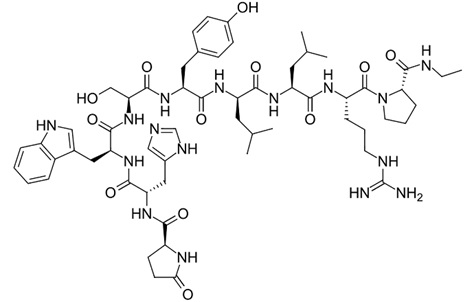
According to Wikipedia, on GnRH Agonist, double and single substitutions in synthetic GnRH agonists at 6, 9, & 10 positions inhibit rapid degradation and give extended and cost-effective responses in the clinical trials and the medical practices under the supervision of experts.
GnRH Antagonists:
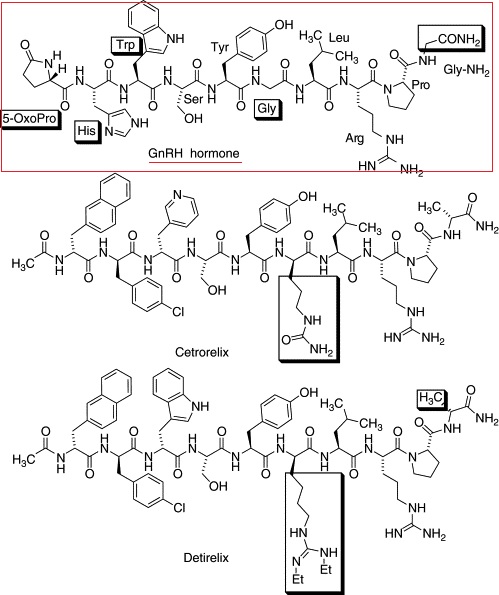
GnRH antagonists are molecules simulating the structure and properties of natural GnRH but blocking the secretion of LH & FSH after binding with GnRH receptors on the targeted cells.
The ultimate occupation of GnRH receptors prohibits further binding of original GnRH molecules released from the pituitary gland and breaks the entire endocrine axis of the female reproductive system.
How Combined Theory Works:
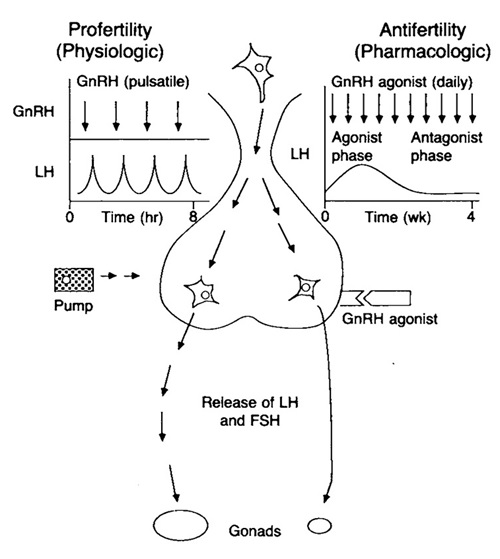
It has been found that after the administration of GnRH agonists, a ten folds increase in LH level was recorded in the clinical trials. Similarly, the testosterone level increased up to 150-200% of the base value. So, it is called flare-effect.
After continuous administration of GnRH agonists, we can achieve a state of hypogonadotropic hypogonadal anovulation. Therefore, it also refers to “pseudo-menopause” or “medical oophorectomy.
However, medically it is not advisable to leave a human in the flare-effect state for long. The GnRH antagonists are playing their roles to reverse the castrate level of testosterone. Alternately, it resumes the normal functions of female reproduction after passing the ovulation and fertility phase.
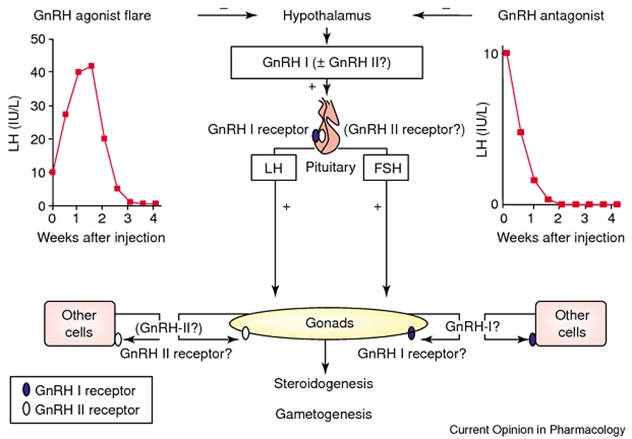
Herbst in Semantic Scholar has published detailed information and beautiful illustrations to make the subject more comprehensive.
The combined and managed treatment of GnRH agonist and antagonist stop the menstruation cycle by inhibiting the secretion of pituitary and gonadal (ovarian) hormones. Thus, low estrogen levels occur and prevent the growth of uterine lining endometriosis and prevent pregnancy.
A GnRH Antibody Theory for Birth Control:
Immunocontraception is not a new concept, but recent advantages concerning fields/branches are promising. According to Wikipedia, immunocontraception uses the immune system of animals and humans to prevent fertility.
There are three different levels of approaches prevailing theoretically, and clinical trials are going on to yield better solutions.
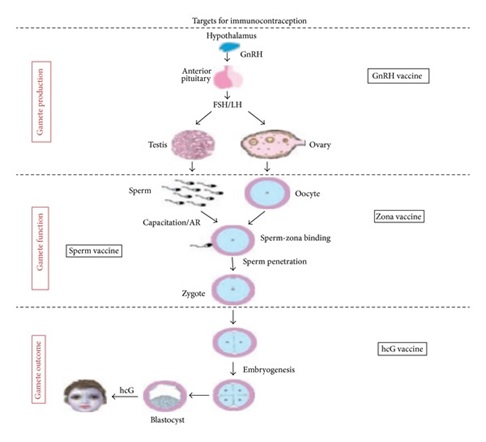
Targeting Gamete Production for Immunocontraception
It inhibits gamete production in both sexes, leading to castration-like effects.
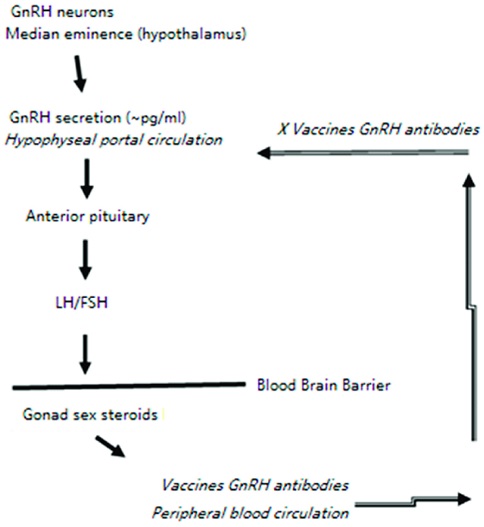
Research Gate has illustrated the entire mechanism most simply. The GnRH antibodies bypass the blood-brain barrier via HPS (Hypothalamus Portal System) and neutralize free molecules of GnRH. Thus, it blocks the downstream signaling for reproduction.
Targeting Gamete Function for Immunocontraception
It prohibits the fertilization of two opposite gametes. So, it offers true contraceptives with safer uses.
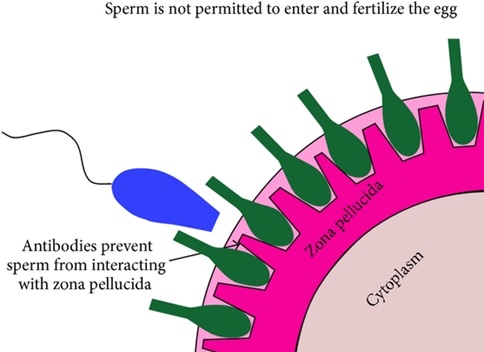
In the journal of BioMed Research International, a beautiful illustration of the function of the sperm vaccine and zona vaccine was found.
Targeting Gamete Outcome for Immunocontraception
It induces abortion of premature zygotes or embryos in females.
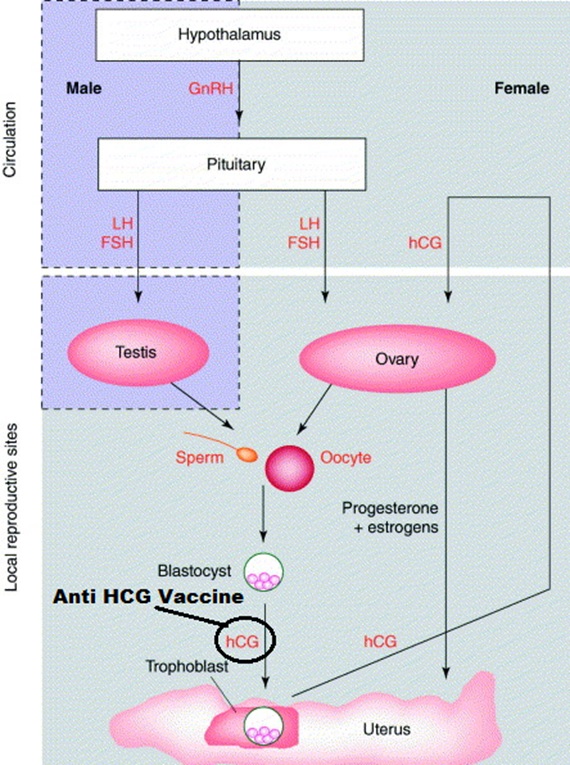
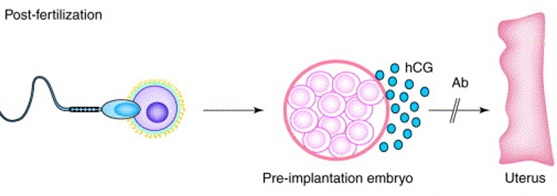
In the journal of Trends in Immunology, the depiction of how the anti-HCG vaccine act on the female reproductive system and prevent birth.
Conclusion:
The role of GnRH in human reproduction is undisputed. The detailed insights into functional aspects of GnRH can give researchers several opportunities to explore various possibilities for birth control. GnRH contraception is possible in males as well as the female reproductive system. However, practical implementation in modern society is awaiting outcomes from the ongoing trials, but prospects are bright.
Citation:
- Nobel Laureates Roger Guillemin and Andrew V. Schally (1977) “The Nobel Prize in Physiology or Medicine 1977”. www.nobelprize.org. Nobel Media AB 2014. Retrieved 24 June 2016.
- John Joseph Reynolds-Wright, Richard A Anderson “Male contraception: where are we going and where have we been?” BMJ Sexual & Reproductive Health, Volume 45, Issue 4, 236.
- Manetti, G., Honig, S. Update on Male Hormonal Contraception: Is the Vasectomy in Jeopardy? Int J Impot Res 22, 159–170 (2010). https://doi.org/10.1038/ijir.2010.2
- Richard E. Jones Ph.D., Kristin H. Lopez Ph.D., in Human Reproductive Biology (Fourth Edition), 2014
